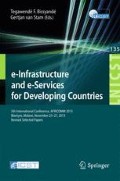Abstract
This paper investigates the effects of connectivity charges (communication costs) on bilateral exports in Sub Saharan Africa (SSA). Data from 19 exporter countries was used together with communication costs data in a gravity model of trade setup. The export data derive from the IMF Direction of Trade and the COMTRADE databases, while the communication cost data was collated from a variety of sources including direct contact with service providers. We find that communication cost is an important factor in bilateral trade in the region. Communications have a significant negative effect on export intensity. The study also reveals that countries with high communication costs generally have lower export intensity than countries with low communication costs. The results suggest that investment in ICT infrastructure that brings down international communication costs will have a positive effect on regional trade in the long run.
Access this chapter
Tax calculation will be finalised at checkout
Purchases are for personal use only
Notes
- 1.
Whether increased intra African trade and trade openness indeed have positive effects on growth in Sub-Saharan Africa is not addressed in the present paper. This remains an important avenue for future research.
- 2.
page 12 in Chapter “Determinants of Bilateral Trade: Does Gravity Work in a Neoclassical World?” appearing in Volume entitled “The Regionalization of the World Economy” from the from the National Bureau of Economic Research.
- 3.
As mentioned in the previous section, only SSA countries are included in the analysis, in order to avoid the confounding effects of strong trade ties to former colonial countries. The focus is on intra-African trade.
- 4.
We tested the results using PPP Dollar GDP figures and found similar results. We show the results obtained using current dollar figures because these were more readily available in a consistent format than the PPP Dollar GDP figures.
- 5.
References
De, P.: The importance of trade costs: a gravity model application. In: 3rd ARTNeT Capacity Building Workshop: UNESCAP, Bangkok (2007)
Freund, C., Weinhold, D.: The effect of the internet on international trade. J. Int. Econ. 62, 171–189 (2004)
Harrigan, J.: Specialization and the Volume of Trade: Do the Data Obey the Laws, NBER Working Paper 8675, December 2001 (2002)
Harris, R.: Trade and communication costs. Can. J. Econ. 28, 46–75 (1995)
Samuelson, P.: The transfer problem and the transport costs: analysis of effects of trade impediments. Econ. J. 64(254), 264–289 (1952)
Brezis, E., Krugman, P.: Technology and the life cycle of cities. J. Econ. Growth 2(4), 369–383 (1997). (Springer)
Venables, A.: Spatial disparities in developing countries: Cities, regions and international trade. CEP Discussion Papers dp0593, Centre for Economic Performance, LSE (2003)
Fink C., Matoo A., Neagu I.: Assessing the impact of communication costs on international trade. World Bank, Development Research Group, Trade: Washington, D.C. (2002)
Tang, L.: Communication costs and trade of differentiated goods. Rev. Int. Econ. 14(1), 54–68 (2006)
van Zon, A., Mupela, E.: Endogenous economic growth through connectivity. UNU-MERIT Working Paper Series 001, United Nations University (2010). (Unpublished)
Anderson, J., van Wincoop, E.: Trade costs. J. Econ. Lit. 42(3), 691–751 (2004)
Anderson, J., van Wincoop, E.: Gravity and gravitas: a solution to the border puzzle. Am. Econ. Rev. 93, 170–192 (2003)
Tinbergen, J.: An Analysis of World Trade Flows. Shaping the World Economy. Twentieth Century Fund, New York (1962)
Baldwin, R., Taglioni D.: Gravity for Dummies and Dummies for Gravity Equations. NBER Working Papers 12516, National Bureau of Economic Research, Inc. (2006)
Bergstrand, J.: The gravity equation in international trade: some microeconomic foundations and empirical evidence. Rev. Econ. Stat. 67(3), 474–481 (1985). (MIT Press)
Bergstrand, J.: The generalized gravity equation, monopolistic competition, and the factor-proportions theory in international trade. Rev. Econ. Stat. 71(1), 143–153 (1989). (MIT Press)
Author information
Authors and Affiliations
Corresponding author
Editor information
Editors and Affiliations
Rights and permissions
Copyright information
© 2014 Institute for Computer Sciences, Social Informatics and Telecommunications Engineering
About this paper
Cite this paper
Mupela, E., Szirmai, A. (2014). Communication Costs and Trade in Sub Saharan Africa: A Gravity Approach. In: Bissyandé, T., van Stam, G. (eds) e-Infrastructure and e-Services for Developing Countries. AFRICOMM 2013. Lecture Notes of the Institute for Computer Sciences, Social Informatics and Telecommunications Engineering, vol 135. Springer, Cham. https://doi.org/10.1007/978-3-319-08368-1_4
Download citation
DOI: https://doi.org/10.1007/978-3-319-08368-1_4
Published:
Publisher Name: Springer, Cham
Print ISBN: 978-3-319-08367-4
Online ISBN: 978-3-319-08368-1
eBook Packages: Computer ScienceComputer Science (R0)

